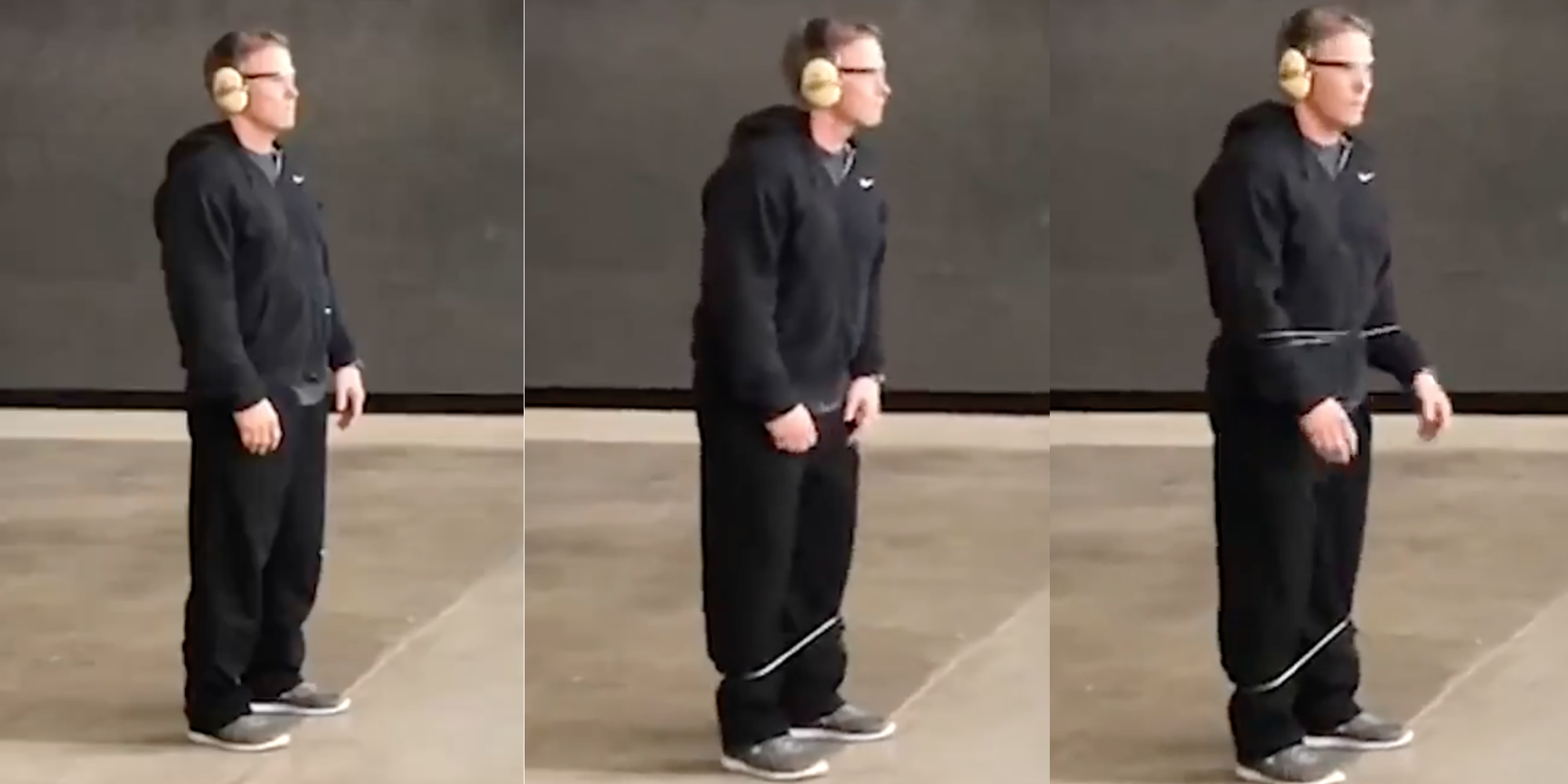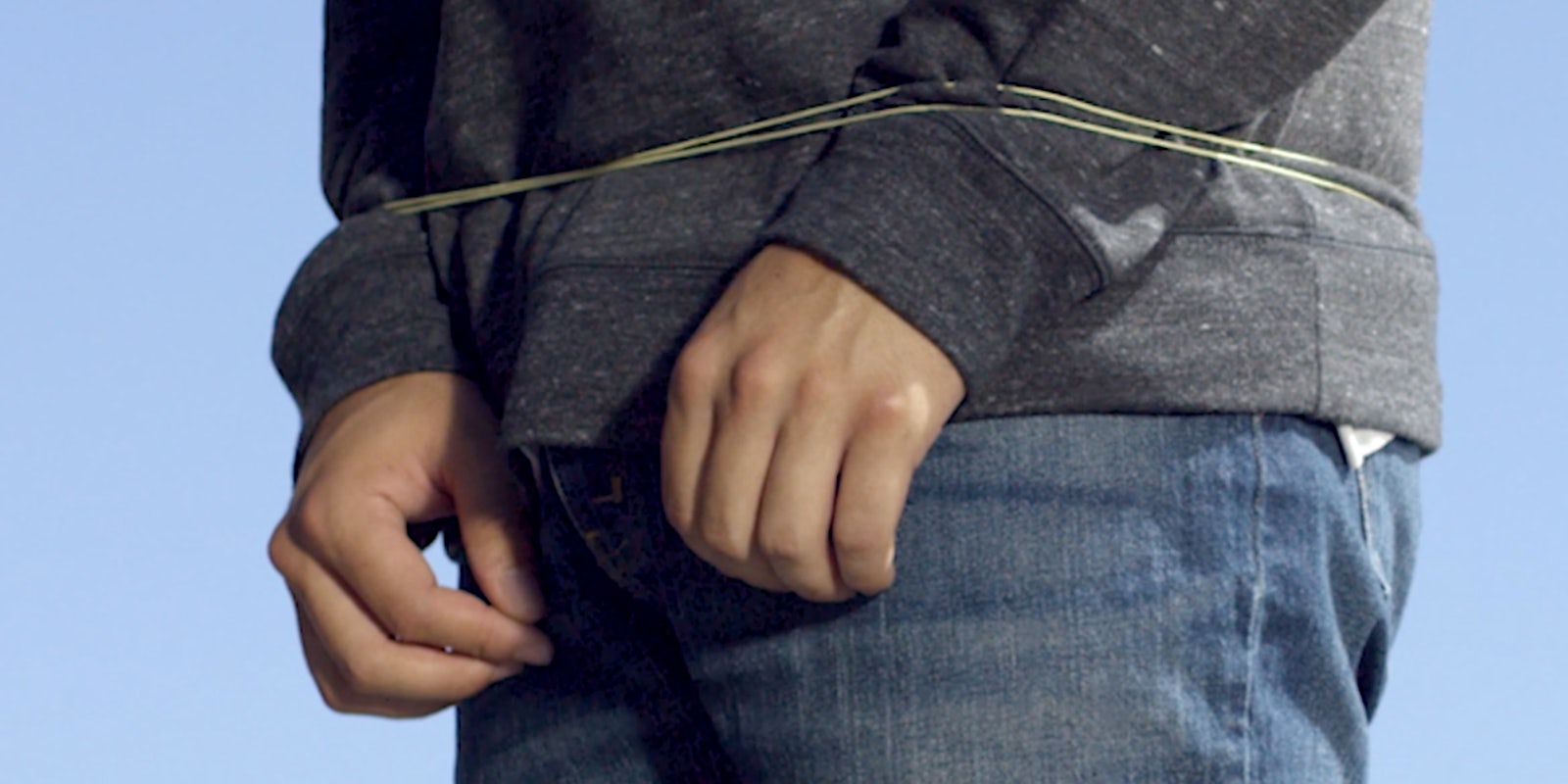Police departments provided body camera footage and testimonials to WRAP, the company that makes the controversial BolaWrap, a high-tech lasso, which are then used to sell it to other agencies.
According to emails obtained with public records requests by the Daily Dot between WRAP and law enforcement agencies, departments readily provided the company with body camera footage of officers deploying the BolaWrap, a device that propels a Kevlar lasso with prongs that wraps around the body of an individual to stop them.
WRAP used these edited versions of these videos to market the BolaWrap. Some of the videos have also appeared in media coverage of the device, including on Fox Business News.
In some instances, departments were also offered a free device after submitting footage.

The BolaWrap has been controversial, being lauded by some as a tool to make policing safer, but also drawn criticism because it is marketed as a tool to subdue individuals with mental health issues. Many of the WRAP’s videos show real deployments of the BolaWrap being used to immobilize someone in the middle of a mental health crisis.
WRAP requests information about any deployments of the BolaWrap in follow-up emails to officers after demonstrations and trainings, based on interviews, email exchanges with departments, and forms reviewed by the Daily Dot. Police departments are more than happy to comply.
WRAP employees wrote in the emails that this follow-up information about deployments helps instructors and other police departments use the BolaWrap properly and would inform future product enhancements. Still, much of the information ends up in promotional emails and on the company’s social media.
“We encourage police departments to share bodycam footage of BolaWrap deployments so the company and other law enforcement agencies can learn from those,” WRAP said ino a statement to the Daily Dot. “When we release a bodycam video, the subject’s face is always blurred.”
WRAP did not specifically respond to numerous detailed questions to the Daily Dot, like why they provided police departments with free wraps.
Some exchanges of information were swift. At the bottom of a report filed a few days after an incident, an officer noted that “all necessary paperwork required for Bola deployment has been forwarded to Wraptechnologies as requested.”
Police departments in Glenwood Springs, Colorado, Wyoming, Minnesota, and Beaufort, South Carolina all provided WRAP with body camera footage, according to correspondence reviewed by the Daily Dot. Other department’s footage also appears redacted and edited on WRAP’s YouTube channel.
Police in Wyoming and South Carolina spoke with the Daily Dot about their relationship with WRAP. The Glenwood Springs Police Department could not be reached for comment by press time.
In all of the videos released by the police, last names of the persons involved are not included, and faces of the individuals are blurred. In all cases, officers who discharged the BolaWrap were trying to subdue an individual who was reportedly dealing with mental health issues and not responding to officers attempts to deescalate the situation.
The Beaufort incident that took place in December 2020 and was caught on an officer’s body camera began with a dispute between an unnamed man and his ex-girlfriend. According to a police report, the man had held knives to his wrist in his ex’s car and asked that she run him over. The former couple then began arguing over a car title.
The report says that police were called to the scene and were informed of the prior incident and that the man was off his medication for schizophrenia. When police arrived, the man repeatedly yelled “shoot me” and displayed the knives towards officers before being persuaded to drop them.
An officer on the scene wrote that he prepared for BolaWrap deployment by getting the man on to grass, away from cement and cars.
The video begins after the knives have been dropped and the man can be seen complaining about a car title with police. When an officer moves far behind him, the unnamed man becomes concerned and distracted, at which point another officer yells “Bola” and deploys the device.
Officers can then be seen converging on the man, who is wrapped up by the Kevlar cord around his arms and yelling “my heart,” as he is pinned to the ground.
Emergency medical services were called and arrived on the scene because of the man’s complaints about his heart, and he was eventually transferred in an ambulance to a hospital for a mental health evaluation, according to the report.
It is on WRAP’s homepage, highlighting “Success Stories.”
The videos WRAP includes on their YouTube channel see a range of views. The body camera footage of the Wyoming incident had just over 4,000 views, while the videos of the Glenwood and Beaufort incidents topped 15,000 and 17,000 views respectively. Though the account has about 4,000 subscribers, one of WRAP’s videos of a demonstration compilation has nearly half a million views, and a real-life deployment in Virginia, Minnesota has received more than 95,000 views.
None of the individuals seen in the videos were charged with crimes, but were taken to receive mental health treatment following their detainment, according to the incident reports.
There were no injuries reported from the use of the BolaWrap in these three videos, according to the reports and videos.
Body camera footage is regulated state by state, and not automatically released to the public. Some state laws restrict the release of videos that include identifying material, may comroprise an ongoing investigation, or include a subject who could be accused, but has not been charged with a crime, according to the National Conference of State Legislators.
In emails, Glenwood Springs Police Department agreed to allow WRAP to share a press release they published about a deployment of the BolaWrap in the city and footage of the incident with local media outlets. Ultimately, Fox Business used part of the body camera footage in a segment.
Wyoming Police Chief Paul Hoppe told the Daily Dot in the interview that the department first redacted and edited the video themselves before releasing the video to WRAP. In Minnesota, body camera footage can be released for training purposes, he said.
Hoppe also approved further editing of the video before WRAP published it to its site and social media, according to Hoppe and emails reviewed by the Daily Dot.
Though the department was offered a free BolaWrap after submitting the footage, Hoppe said they have not received it yet and that it was not until after submitting that he was aware of the offer.
Hoppe said that although he knows WRAP could use the footage to sell its devices, he was motivated by the opportunity to show other departments that it worked.

The controlled demo videos were not what convinced Hoppe to use the device for his own department, he said, instead insisting the body camera footage of real-life situations persuaded him.
“Those are the ones we want to see from a law enforcement perspective because that’s how it’s going to be applied,” he said.
In the case of the video from Beaufort, the department agreed to share the footage only if WRAP was able to edit the video to blur out faces and redact a portion of the video where the individual’s name was used. The department also reviewed the edited footage before allowing WRAP to use it, according to an email exchange reviewed by the Daily Dot.
Beaufort Police Department also received a free BolaWrap for sending in footage, but Captain George Erdel, the public information officer for Beaufort PD, said that he was only aware he would be sent a free BolaWrap after submitting information about the incident to WRAP.
Erdel, who had originally suggested the department start using the BolaWrap, told the Daily Dot that it wasn’t an easy decision to submit video, saying that it was a conversation among him and other high-ranking officers at the department.
Ultimately, Erdel said that the department felt that sharing the footage could do some good by showing other departments that the BolaWrap worked during the incident in Beaufort, decreasing some of the skepticism about its effectiveness and encouraging other agencies to use it.
“If one person doesn’t have to get tasered, or if one person doesn’t have to get dog piled and then have a medical episode and unfortunately die, and instead they are wrapped up with a Kevlar cord that can be cut off with a pair of sheers” because a department decided to implement the BolaWrap after watching the Beaufort deployment, he said sharing the video would be worth it.
John Raphline, a senior researcher for the American branch of Human Rights Watch, argued that force doesn’t always have to be a part of the equation.
“The options aren’t non-lethal or lethal force. There’s another option which is no force at all, which really gets to the fundamental issue, why is mental health a policing issue?” he said in an interview with the Daily Dot.
“It’s insane that this is our response to a person who is unhealthy, who has a mental health condition, who is suffering in some way is, ‘we now have a tool where we can tie their legs up from a distance,’” Ralphing, who has written about the increased use of high-tech weapons, including the BolaWrap, added.
“I see both sides of the issue,” Chief Hoppe said. The BolaWrap “is not a solve-all by any means,” but he thinks it can be a better option than a Taser or other more potent uses of force in some situations.
As to possible concern that the WRAP could profit off of the videos, Erdel said that, “if (the body camera footage) becomes a commercial and somebody wants to criticize us because the company made money off us, I’ll take that criticism all day.”
“I think that’s a small price to pay for sending video out,” he added.
Raphling disagreed and said that publishing video of real-life use of the BolaWrap in incidents involving individuals who are going through a mental health crisis is “extremely harmful unless you are a shareholder of the company.”
“The more we sell these forceful, violent tools,” Raphling said, “the less we are looking at what we should actually do about people with mental health conditions.”

